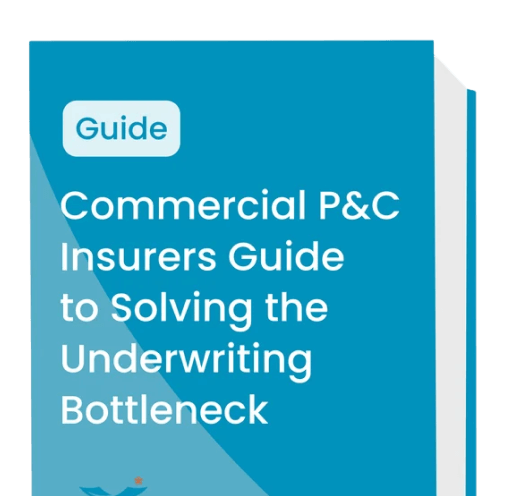
2024 AI Trends in Insurance
The Property and Casualty (P&C) insurance sector faces many complex challenges. Inflation, climate change, and social unrest have led to increasing losses, and a hardening reinsurance market makes it more difficult than ever to sustain growth.
No wonder P&C carriers worldwide are looking for new, agile approaches to doing business. For many, that means evaluating new technology to see if it can help them get ahead of those thorny market and societal challenges. Artificial intelligence (AI) is one such technology on the minds of many, and for good reason. It holds great potential for improving workflows in insurance companies—everything from triaging underwriting submissions to customer communication, marketing, and assisting with claims processing.
AI is not a panacea, though. It won’t miraculously solve every single technical and labor problem insurance companies face. So, how can it best fit into P&C insurance operations? Carriers are just now starting to understand how it will be.
We polled our field experts and shared their insights on the major trends in AI P&C insurance carriers can expect to see this coming year. We explore AI's wider social and economic impact in 2024 and beyond.
Key technological and societal trends in AI that will shape 2024
AI is a far-reaching technology. This trends article doesn’t limit itself to technological forecasts. We consider the implications of introducing AI into business processes and business culture.
Wider P&C applications for Machine Learning (ML)
Powerful ML insurance tools are already on the market today, but many insurers are now considering integrating them into their workflows. Some tools are well-suited for very narrow language processing use cases, such as high-volume data extractions standardized forms.
However, newer, advanced tools are more flexible. They can work with unstructured data sources like policy documents, claims forms, loss runs, and other financial statements submitted with an underwriting application. Insurers can use these ML/AI tools to parse volumes of dense, unstructured documents more easily and extract relevant information for their claims or underwriting processes.
New understanding that AI functions best as a copilot
In the early days, many workers feared companies would see AI as a tool to eliminate jobs. AI can certainly automate lower-skill labor in certain contexts, but fully replacing professionals in the insurance industry can be difficult. The more knowledge work and contextual understanding are necessary, the more you need a human in the loop (HitL).
In 2024 and beyond, many insurance companies will pivot towards HitL AI initiatives. In other words, they are using AI as a support to make life easier for skilled professionals without replacing them. Underwriting decisions, for example, are most effectively made when a human expert applies their judgment to data extracted by AI, along with contextual insights and deep industry understanding.
Transparency and ethical AI considerations
As Artificial Intelligence (AI) takes on a more significant role in insurance broadly and underwriting specifically, the demand for transparency, explainability, and adherence to industry and ethical standards is increasingly critical. Likewise, regulatory bodies are focusing on the ethical use of AI technologies.
Consequences of underwriting decisions can have a significant financial impact on all parties involved, as well as potential human health and safety concerns. Suppose insurers are going to use AI models in their decision-making processes. In that case, those models should explain their recommendations clearly so underwriters can grasp their logic. Trust, but verify.
We will also see increasing efforts within the insurance industry to ensure that AI models are fair and free from biases that could lead to discriminatory outcomes. This focus aims to guarantee equal treatment for all customers by identifying and correcting bias within AI algorithms.
Challenges in prioritizing new AI initiatives
While AI has a promising future in P&C insurance, the race to embrace this new technology brings new challenges. For one, how do you prioritize your AI initiatives?
At a high level, aligning technological investments with strategic business objectives is important. With limited resources and pressure from senior leadership to deliver value to the organization, insurance professionals must find a balance between the AI projects they pursue that provide concrete value in the near term and those with greater, longer-term potential. That’s before balancing AI projects against other priorities, such as systems maintenance and major security updates.
Identifying the correct projects requires a deep understanding of the evolving market demands, regulatory changes, and the competitive landscape. Sometimes, choosing near-term or long-term focused AI projects is a choice. However, some of the latest generation of AI augmentation tools are flexible enough to offer both.
Navigating the AI hype in 2024
A lot of noise usually accompanies the emergence of new, transformative technologies. Slews of new buzzwords, misrepresentations, and plain misunderstanding of what a new technology is and what it is capable of are common. The noise surrounding the current wave of generative AI, machine learning (ML), and NLP is no exception.
Smart insurance companies will be discerning about the AI tools they consider as we move further into 2024. We’ll continue to be inundated with claims of revolutionary breakthroughs and new methods, each service promising to be the next big thing.
Yet, despite all the hype and noise, decision-makers still need to make decisions about AI. Insurers must develop a keen sense of identifying substantive advancements that have the potential to drive real change and focus on solutions that offer practical benefits today and tomorrow. By better understanding the landscape of AI in 2024, P&C commercial insurers can cut through the hype and make technology investments that are both strategic and impactful.
Forge a new path in 2024 by leveraging SortSpoke
Sortspoke is the premier platform for managing complex unstructured insurance data. It can manage simple documents out of the box, and when paired with human experts, it can process unstructured documents up to five times faster than traditional methods. Our support extends to various formats, including MS Office files, images, tables, emails, PDFs, handwritten notes, and even password-protected documents, catering to a global clientele with capabilities in any language that utilizes the Latin alphabet.
These comprehensive data processing capabilities provide unmatched efficiency and support to underwriters. Through our innovative solutions, we're not just processing data. We're transforming the landscape of insurance underwriting for the better.
Read More









